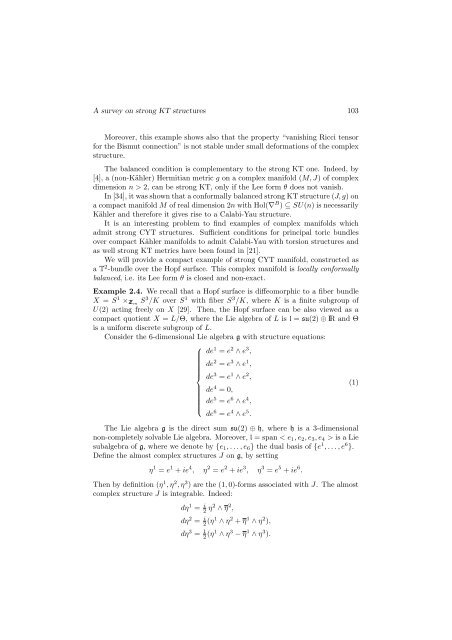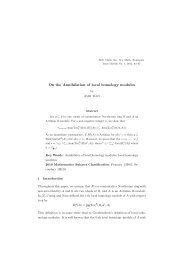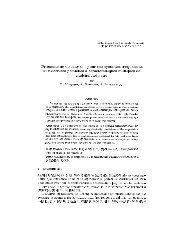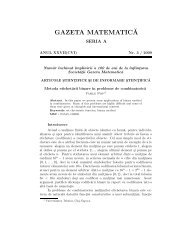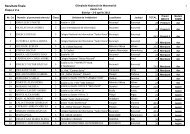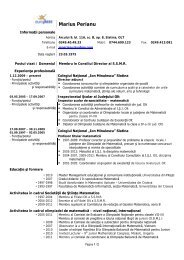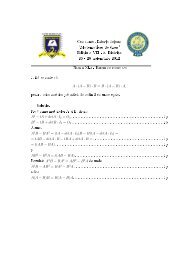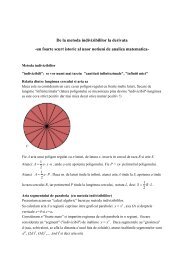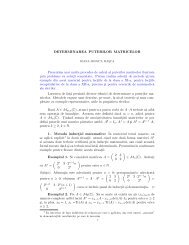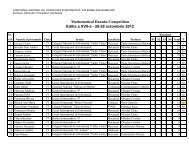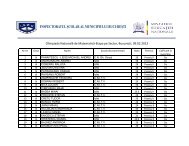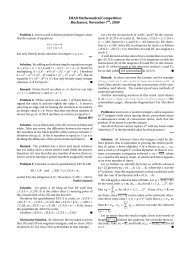A survey on strong KT structures - SSMR
A survey on strong KT structures - SSMR
A survey on strong KT structures - SSMR
Create successful ePaper yourself
Turn your PDF publications into a flip-book with our unique Google optimized e-Paper software.
A <str<<strong>strong</strong>>on</<strong>strong</strong>>g>survey</str<<strong>strong</strong>>on</<strong>strong</strong>>g> <<strong>strong</strong>>on</<strong>strong</strong>> str<<strong>strong</strong>>on</<strong>strong</strong>>g <strong>KT</strong> <strong>structures</strong> 103Moreover, this example shows also that the property “vanishing Ricci tensorfor the Bismut c<<strong>strong</strong>>on</<strong>strong</strong>>necti<<strong>strong</strong>>on</<strong>strong</strong>>” is not stable under small deformati<<strong>strong</strong>>on</<strong>strong</strong>>s of the complexstructure.The balanced c<<strong>strong</strong>>on</<strong>strong</strong>>diti<<strong>strong</strong>>on</<strong>strong</strong>> is complementary to the str<<strong>strong</strong>>on</<strong>strong</strong>>g <strong>KT</strong> <<strong>strong</strong>>on</<strong>strong</strong>>e. Indeed, by[4], a (n<<strong>strong</strong>>on</<strong>strong</strong>>-Kähler) Hermitian metric g <<strong>strong</strong>>on</<strong>strong</strong>> a complex manifold (M,J) of complexdimensi<<strong>strong</strong>>on</<strong>strong</strong>> n > 2, can be str<<strong>strong</strong>>on</<strong>strong</strong>>g <strong>KT</strong>, <<strong>strong</strong>>on</<strong>strong</strong>>ly if the Lee form θ does not vanish.In [34], it was shown that a c<<strong>strong</strong>>on</<strong>strong</strong>>formally balanced str<<strong>strong</strong>>on</<strong>strong</strong>>g <strong>KT</strong> structure (J,g) <<strong>strong</strong>>on</<strong>strong</strong>>a compact manifold M of real dimensi<<strong>strong</strong>>on</<strong>strong</strong>> 2n with Hol(∇ B ) ⊆ SU(n) is necessarilyKähler and therefore it gives rise to a Calabi-Yau structure.It is an interesting problem to find examples of complex manifolds whichadmit str<<strong>strong</strong>>on</<strong>strong</strong>>g CYT <strong>structures</strong>. Sufficient c<<strong>strong</strong>>on</<strong>strong</strong>>diti<<strong>strong</strong>>on</<strong>strong</strong>>s for principal toric bundlesover compact Kähler manifolds to admit Calabi-Yau with torsi<<strong>strong</strong>>on</<strong>strong</strong>> <strong>structures</strong> andas well str<<strong>strong</strong>>on</<strong>strong</strong>>g <strong>KT</strong> metrics have been found in [21].We will provide a compact example of str<<strong>strong</strong>>on</<strong>strong</strong>>g CYT manifold, c<<strong>strong</strong>>on</<strong>strong</strong>>structed asa T 2 -bundle over the Hopf surface. This complex manifold is locally c<<strong>strong</strong>>on</<strong>strong</strong>>formallybalanced, i.e. its Lee form θ is closed and n<<strong>strong</strong>>on</<strong>strong</strong>>-exact.Example 2.4. We recall that a Hopf surface is diffeomorphic to a fiber bundleX = S 1 × Zm S 3 /K over S 1 with fiber S 3 /K, where K is a finite subgroup ofU(2) acting freely <<strong>strong</strong>>on</<strong>strong</strong>> X [29]. Then, the Hopf surface can be also viewed as acompact quotient X = L/Θ, where the Lie algebra of L is l = su(2) ⊕ IR and Θis a uniform discrete subgroup of L.C<<strong>strong</strong>>on</<strong>strong</strong>>sider the 6-dimensi<<strong>strong</strong>>on</<strong>strong</strong>>al Lie algebra g with structure equati<<strong>strong</strong>>on</<strong>strong</strong>>s:⎧de 1 = e 2 ∧ e 3 ,de 2 = e 3 ∧ e 1 ,⎪⎨ de 3 = e 1 ∧ e 2 ,(1)de 4 = 0,de⎪⎩5 = e 6 ∧ e 4 ,de 6 = e 4 ∧ e 5 .The Lie algebra g is the direct sum su(2) ⊕ h, where h is a 3-dimensi<<strong>strong</strong>>on</<strong>strong</strong>>aln<<strong>strong</strong>>on</<strong>strong</strong>>-completely solvable Lie algebra. Moreover, l = span < e 1 ,e 2 ,e 3 ,e 4 > is a Liesubalgebra of g, where we denote by {e 1 ,...,e 6 } the dual basis of {e 1 ,...,e 6 }.Define the almost complex <strong>structures</strong> J <<strong>strong</strong>>on</<strong>strong</strong>> g, by settingη 1 = e 1 + ie 4 , η 2 = e 2 + ie 3 , η 3 = e 5 + ie 6 .Then by definiti<<strong>strong</strong>>on</<strong>strong</strong>> (η 1 ,η 2 ,η 3 ) are the (1,0)-forms associated with J. The almostcomplex structure J is integrable. Indeed:dη 1 = i 2 η2 ∧ η 2 ,dη 2 = i 2 (η1 ∧ η 2 + η 1 ∧ η 2 ),dη 3 = 1 2 (η1 ∧ η 3 − η 1 ∧ η 3 ).


